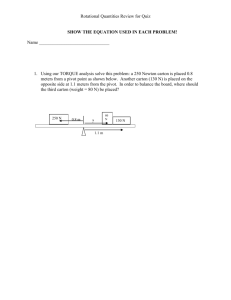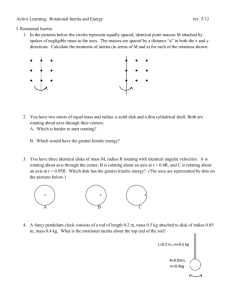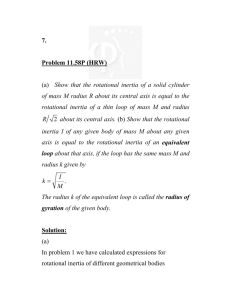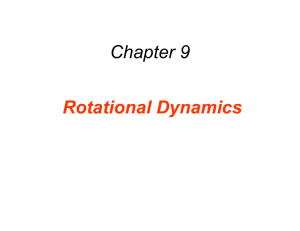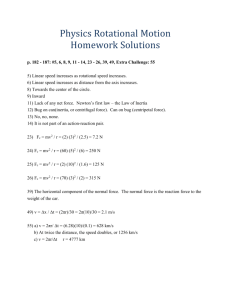Topic 2_2_Ext G__Rotational dynamics
advertisement
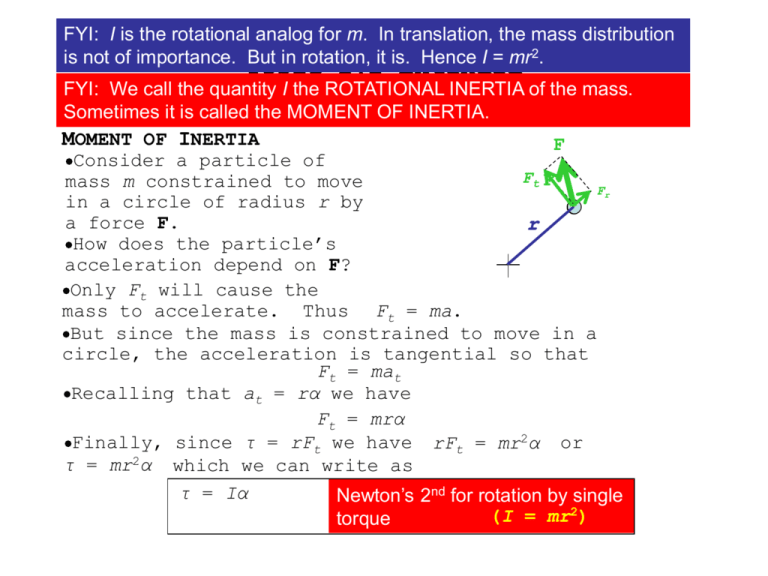
FYI: I is the rotational analog for m. In translation, the mass distribution is not of importance. But in rotation, it is. Hence I = mr2. Topic 2.2 Extended We call the G quantity I the ROTATIONALdynamics INERTIA of the mass. – Rotational FYI: Sometimes it is called the MOMENT OF INERTIA. MOMENT OF INERTIA F Consider a particle of Ft F mass m constrained to move Fr in a circle of radius r by a force F. r How does the particle’s acceleration depend on F? Only Ft will cause the mass to accelerate. Thus Ft = ma. But since the mass is constrained to move in a circle, the acceleration is tangential so that Ft = mat Recalling that at = rα we have Ft = mrα Finally, since τ = rFt we have rFt = mr2α or τ = mr2α which we can write as τ = Iα Newton’s 2nd for rotation by single (I = mr2) torque Topic 2.2 Extended G – Rotational dynamics MOMENT OF INERTIA The moment of inertia for a group of point masses about a given axis is I = mr2 Rotational Inertia Point Masses Calculate the rotational inertia of the masses about the axis shown. 4 kg I = Σmiri2 2.0 m = 1·12 + 2·2.52 + 4·32 = 49.5 kg·m2 2 kg If a torque of 15 nm was 1.0 m 1 kg applied to the axis, what would the rotational acceleration be? 2.5 m τ = Iα 15 = 49.5α α = 0.303 rad/s2 Topic 2.2 Extended G – Rotational dynamics MOMENT OF INERTIA Why is Ihoop > Idisk for same M and R? Furthermore, the rotational inertia depends on the location of the axis of rotation. R Hoop I = MR2 R Disk/Cylinder I = 12 MR2 R axis mass distributions have different rotational inertias. axis Different continuous R Hoop about diameter Disk/Cylinder 1 I = 12 MR2 I = 14 MR2 + 12 ML2 Topic 2.2 Extended G – Rotational dynamics MOMENT OF INERTIA or hollow. Which is greater Isphere or Ishell? Why is Ishell > Isphere for same M and R? R R Solid sphere I = 25 MR2 So can disks. If R1 = R2 what does the ring become? If R1 = 0 what does the ring become? axis axis Spheres can be solid R2 R1 Annular cylinder/Ring 1 I = 2 M(R12+R22) Spherical shell I = 23 MR2 Topic 2.2 Extended G – Rotational dynamics MOMENT OF INERTIA axis rotated about a variety of perpendicular axes. Here are two: axis A thin rod can be L L Thin rod about center, ┴ 1 I = 12 ML2 Thin rod about end, ┴ I = 13 ML2 Why is Irod,cent < Irod,end? Topic 2.2 Extended G – Rotational dynamics MOMENT OF INERTIA Finally, we can look at axis a slab rotated through a perpendicular axis: Why doesn’t the thickness of the slab matter? b a Slab about center, ┴ 1 I = 12 M(a2+ b2) Topic 2.2 Extended G – Rotational dynamics MOMENT OF INERTIA = 1 2 12 ·30(2 + 42) axis What is the rotational inertia of a 2-m by 4 m, 30-kg slab? M = 30, a = 2 and b = 4 so that 1 I = 12 M(a2+ b2) b a = 50 kg·m2 What torque applied to the axis of rotation will accelerate the slab at 2.5 rad/s2? τ = Iα τ = 125 n·m τ = 50(2.5) Slab about center, ┴ 1 I = 12 M(a2+b2) Topic 2.2 Extended G – Rotational dynamics THE PARALLEL AXIS THEOREM Notice that most of the axes for the previous rotational inertias were through the center of mass. Engineers would like to know the rotational inertia through other axes, too. Fortunately it is not necessary to list an infinite number of I’s for each extended mass. Instead, the parallel axis theorem is used: If you know Icm then you can find I about any parallel axis using I = Icm + Md2 Parallel Axis Theorem Where M is the total mass of the extended object, and d is the distance from the center of mass to an axis parallel to the cm axis. FYI: We just added the rotational inertias of the constituent parts to get the total rotational inertia. Topic 2.2 Extended G – Rotational dynamics THE PARALLEL AXIS THEOREM Suppose a 200-kg solid sphere of radius 0.1-m is placed on the end of a 12-kg thin rod of length 8 m. 12 kg 200 kg 8m .1 m Since the rod already has a formula for Irod,end, we’ll find its rotational inertia first: 1 Irod,end = 13 ML2 = 3 ·12·82 = 256 kg·m2 Since the sphere is not rotating about its cm, we must use the parallel axis theorem, with d = 8.1 m: I = Icm + Md2 = Then 2 MR2 5 + Md2 = = 2 ·200·0.12 5 + 200·8.12 13122.8 kg·m2 Itot = 256 + 13122.8 = 13378.8 kg·m2 Topic 2.2 Extended G – Rotational dynamics APPLICATIONS OF ROTATIONAL DYNAMICS Consider a disk-like pulley of α mass m and radius R. A string is connected to a block of mass M, and wrapped around the pulley. What is the acceleration of the block as it falls? We can insert the forces into our diagrams, important dimensions, and accelerations. m R M T Note: The acceleration of the pulley is angular, α. T Note: The acceleration of the block is linear, a. a Mg Note: At this point we have 3 unknowns, but only 2 equations. WE Topic 2.2 Extended NEED ANOTHER EQUATION… G – That Rotational dynamics equation is a = Rα. Question: If the mass the pulley isDzero what is the expected A PPLICATIONS OF Rof OTATIONAL YNAMICS acceleration of the mass M? Now we get ourfalling equations: For the pulley, τ = Iα. m Since T is tangent to the R pulley, at a distance R from the pivot point, τ = RT. 1 Since for a pulley I = mR2 2 ΣF = Ma τ = Iα T = 1 2α mR 2 1 mRα 2 T - Mg = -Ma ma = Mg - Ma T T = Mg - Ma a = Rα → α = a/R 1 2 T Block analysis Pulley analysis RT = α → T = → a = 1 2 2Mg 2M + m ma a M Mg

